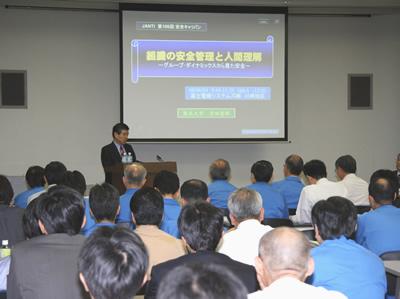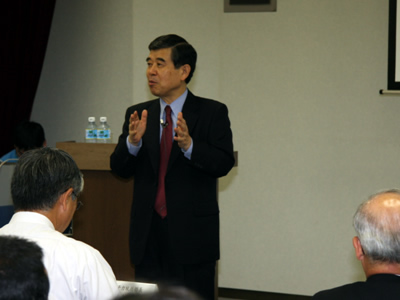
|
|
During the Safety Presentation
|
Approx. 120 employees of Fuji Electric Systems Co., Ltd.'s Kawasaki plant and employees of contractor companies attended the Safety Presentation.
The presentation began with a salutation by Mr. Naoto Yoneyama, Director and General Manager of the Fuji Electric power plant.
"The key word 'Safety' encompasses a wide range of meanings. Safety is a matter of course in regard to the systems and machinery we handle in our routine daily work duties, and personal safety and environmental safety are varied. We must always act in regard to products and their operation keeping safety in mind.
"A German company that I was involved with drew up what they called a 'Safety Concept.' More specifically, all safety endeavors within the company are compiled into a manual and endeavors are made to follow the manual without fail. When receiving an order from a customer, everything is reviewed with regard to the system as to how safety everything needs to be in order to provide the product or service. If something is not right, the company will not accept the job. That is really how rigidly managed the system was. That way of thinking enhanced throughout the entire company, and I have personally already experienced the conditions of such tight control."With regard to safety endeavors, and this is my own personal opinion, I believe Japan is far more advanced than other countries. On the other hand, recently the West is endeavoring to catch up and very enthusiastic efforts are being made toward 'safety,' including the issue of compliance. Consequently, I believe we must take our awareness of safety to a higher level, and it is our aim to reach further improvement. "
Following this introduction, Professor Michio Yoshida of Kumamoto University gave a lecture titled "the Safety Management of an Organization and Human Understanding -- Safety as Seen from the Perspective of Group Dynamics." |

|
|
Professor Michio Yoshida
of Kumamoto University
|
●Group dynamics is the study of human behavior as the individual relates to the group, and the fundamental conception is that "it is not possible to understand human nature without taking into account the relation to the group." Taking a look at human behavior, even when a person acts in solitude, the relation to the group is an ever-present force, and the "power of the group" is a major influence. Therefore, to seek out rules of human behavior and to make effective use of those rules can be considered an effective means of safety assurance. At first, we take out common sense in the workplace, in other words, we find out one type of rule. Then we need to take notice of merits and weaknesses of the this rule in the viewpoint from the outside.
●These rules can also be found in routine daily life. For instance, there is a de facto "rule of seating" in auditoriums such as we are in today, that people tend not to sit too close to the front. Rules of a similar nature, or standards of behavior, also exist in the workplace, and it is important to discover such rules and lead to the specific solutions.
●Safety can be thought of as "Fail Safe and Feel Unsafe;" in other words, in addition to hardware for ensuring safety, on the human side it is also important to have the feeling of "if I do this, I wonder if it would have negative consequences?" Also, workplace safety can not be ensured simply by possessing knowledge about safety. One must first have an awareness that leads to taking real action. Another thing is that it is important for our selections to be made based on "certainty" rather than "probability." Besides that, when we have committed a failure or mistake, we need to apologize with earnestness. It is important to make workplace climate that the straight talk of individual about the mistake is recognized. In addition to following the manuals and obeying the set rules with "naively honest stubbornness," if there is some problematic point or points, changes must be made proactively "with quick flexibility" without fail.
●There are what are known as "the devil's rules" in human errors, some typical ones being "becoming too accustomed," " wrong estimation of experience," and "memory and forgetfulness" just to name a few. Add to this the realities of "even though the manual was breached, it may not necessarily lead to an accident" and "even though the manual was followed, an accident may occur anyway" which take on the devilish role of inducing accidents. We should be conscious of these human traits and challenge our own jobs, taking responsibility and pride in creating a safety workplace.
Comments from the questionnaires conducted after the presentation:
●The explanation of human group behavior characteristics was very easy to understand and I believe we can put it to good use in avoiding such traps. Because of the talk being about the group, it seemed to me that the contents were the understanding and analysis of actual feelings perceived by individuals at the worksite. Even when the dangers of group behavior are known, why is it that not even one person among the group takes corrective action? What should be done about it? Asking each individual person is necessary, I believe, in order to foster safety culture.
●I could listen to the lecture all the way through right to the end without getting bored, because the lecture was good, easy to understand and with plenty of actual examples. The topic is one that we are generally not consciously aware of, and focused only on important matters, making it quite worthwhile. Just as leadership is a topic of research, this has caught my interest and I plan to check this out on the homepage.
●The lecture was easy to understand and had close topics. I would like to reflect back on the talk. The extremely obvious "from probability to certainty" becomes not so obvious, and from now on I will talk about this not only at the workplace but at home as well.
●The explanation of threats to safety that lurk in human behavior hit close to home and is a useful reference. On the professor's homepage I will look up those topics that were not covered during the lecture due to lack of time.
● Through the use of easy-to-understand examples, the lecture took this stiff topic and brought it close to home and made it easy to understand. Especially when it comes to the sorting out of characteristics and activities of mind, I felt that it provided impetus to take a fresh look at our day to day activities.
●I understood that the actions of individual persons are intertwined with the group and the consequence thereof. The lecture was very fresh and educational, allowing me to notice anew certain things about the relation between safety and communication for the first time. |
At the request of Fuji Electric Systems, Mr. Toshio Kojima, Manager of the Plant Design Group, Nuclear Plant Support Department, IHI Nuclear Power Division attended the safety information exchange session and presented a detailed explanation of "Overview of the 'Handing Down and Acquisition of Engineering Skills' Action Program within IHI Nuclear Power Division."
After the presentation, opinions were exchanged regarding the above mentioned endeavors. |







